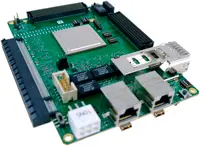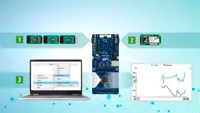Electronics News
Archive : 8 July 2021 год
 Aldec has extended its TySOM family of embedded prototyping boards with the introduction of the TySOM-M-MPFS250.
Aldec has extended its TySOM family of embedded prototyping boards with the introduction of the TySOM-M-MPFS250.
The board is the first in a planned series to feature a Microchip PolarFire SoC FPGA MPFS250T-FCG1152 and to have dual FMC connectivity.
The PolarFire SoC FPGA offers low power consumption, improved thermal efficiency and defence-grade security making it suitable for smart, connected systems. It is also the first SoC FPGA to provide a coherent RISC-V CPU cluster and a deterministic L2 memory subsystem - making it capable of running Linux and real-time applications.
The RISC-V CPU micro-architecture implementation is a five-stage single issue in-order pipeline. The five cores are 1x SiFive E51 Monitor core (RV64IMAC) and 4x SiFive U54 Application cores (RV64GC). Of these five, four can be used for the Linux OS. The SoC FPGA also includes 254K of FPGA logic elements, LSRAM, uPROM and uRAM.
In terms of board memory, the TySOM-M-MPFS250 contains 16Gb FPGA DDR4 x32, 16Gb MSS DDR4 x36 with ECC, eMMC, SPI Flash memory, 64 Kb EEPROM and a microSD card socket. In addition to the dual FMC connectivity, there are 2x Ethernet 10/100/1000, 1x USB 2.0, a USB to UART bridge, a PCIe x4 Gen2 root, CAN and HDMI OUT interfaces for external communications.
“Microchip PolarFire SoC FPGA devices are the lowest power, multi-core SoC FPGAs on the market,” commented Krishnakumar R, product marketing and Mi-V ecosystem manager at Microchip Technology. “PolarFire SoC FPGAs also enable triple-layer security that protects the hardware, design and data, plus each processor core has physical memory protection, to enforce access restrictions depending on the machine’s privilege state. Aldec’s decision to use PolarFire SoC FPGA in its new TySOM-M family will enable users to design for a wealth of applications requiring low power and high security.”
Zibi Zalewski, General Manager of Aldec’s Hardware Division, added, “Our TySOM-M debut board inherits all the features and benefits of the PolarFire SoC FPGA. These, combined with the board’s own features and benefits, provide engineers with a highly versatile platform for developing applications. The board’s ability to connect to two FMC daughter cards also means it can be used in virtually any industry sector without having to develop custom hardware. This really is a powerful plug-and-play solution.”
Zalewski said that the debut board in Aldec’s new TySOM-M series can accommodate larger PolarFire SoC FPGAs, as and when they become available, and that the boards for prototyping designs targeting those devices would be available shortly after as part of the company’s commitment to RISC-V.
Author
Neil Tyler
Source: www.elevatesemi.com
 Renesas has released an IoT system design platform that it says will significantly simplify the prototyping of IoT systems.
Renesas has released an IoT system design platform that it says will significantly simplify the prototyping of IoT systems.
The Quick-Connect IoT system consists of standardised boards and interfaces, enabling designers to connect a wide range of sensors to MCU development boards. The new system also delivers core software building blocks that are portable between boards, greatly reducing coding requirements.
In developing the Quick-Connect IoT system, Renesas has worked with Digilent, in creating a new expanded I2C Pmod Interface, Type 6A, for wider coverage and added flexibility. Renesas has chosen to standardise on the new Pmod 6A connector from Digilent for new sensor Pmods and MCU development kits. This will allow designers much greater flexibility in selecting the optimal combination for any IoT prototype design. MCU boards will have two Pmod connectors, one for a sensor Pmod, and another for a communications module. The Pmods can also be cascaded for even greater flexibility.
Renesas has also redefined common software APIs (Application Program Interfaces) and HAL (Hardware Abstraction Layer) code for a wide variety of sensors. These are embedded into the Renesas e2 studio integrated development environment. Now, instead of writing and testing hundreds of lines of driver code, designers will be able to graphically select their sensor and write a few lines of code. All the integration and setup effort is taken care of behind the scenes, reducing the time to a working solution.
Initially, Quick-Connect IoT will include over a dozen new Renesas sensor Pmods and other modular boards, including air quality sensors, flow sensors, bio-sensing, time of flight, temperature and other sensing elements. Additional Renesas sensor Pmods are under development that will include a variety of sensors and peripherals.
Over 25 MCU development boards and kits spanning the RA, RX and RL78 families are compatible with the new Pmod Type 6A standard, either directly or through a small interposer board developed by Renesas. RE and RZ development boards will be supported in the near future.
Author
Neil Tyler
Source: www.elevatesemi.com
